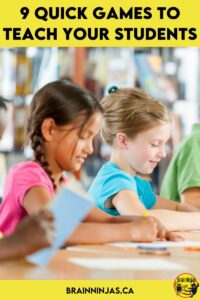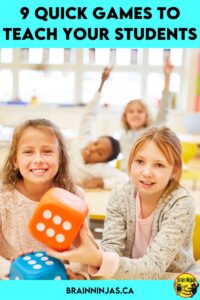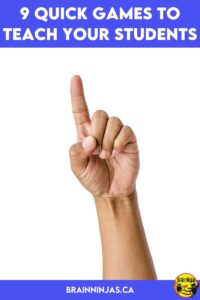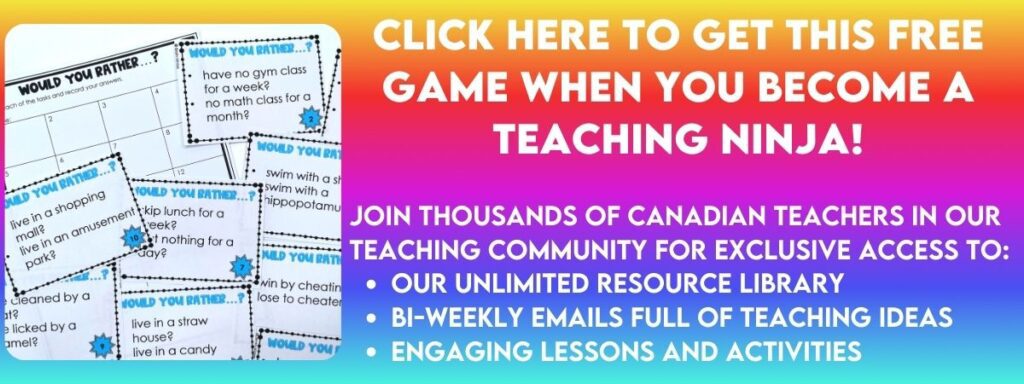
The pressure is always on teachers to move through the curriculum and to use their learning time as wisely as possible. We agree. There are already enough interruptions to learning these days that you don’t need to create more distractions. So, why would we encourage you to place games with your students? Quick games are one way we build relationships, teach students to follow directions, teach our classroom management expectations and foster teamwork between classmates. Come read some of our favourite quick games you can use in your upper elementary classroom or with your fellow teachers.
What do quick games teach students?
Playing games teaches students how to work together, take turns, follow rules and develop strategies. Students learning English benefit from playing games to practice English during informal activities that are a little structured. Your students will build relationships with each other and with you if you are also playing along.

Best of all, sometimes a little game is the perfect thing to refresh your students’ minds. We use these games as brain breaks, during transitions or even as rewards.
The games in this post are quick, but not always quiet. If you’re looking for games that aren’t so noisy, you might want to check out our post Quiet Classroom Games You’ll Love.
And just in case it’s not clear, don’t play all these games at once with your students. Spread them out and then when your students are having a rough day and need a pick me up, choose a new one. If you’re looking for more free activities for the first month of school try this post.
If you enjoy the games below, you might also enjoy our Classroom Community Unit. It’s full of activities to help your students form relationships, work together and problem-solve as classmates. You can find it in our TpT Store ($USD) and BN Shop ($CAN).
Elevensies
We found this game from @sabocat on TikTok it’s genius!
Number of Players: 4 per group
Materials: nothing
How to Play: Divide students into groups of four. They don’t need to touch or sit together, but they need to be able to see each other.
Each student puts one hand behind their back. Give a signal like 1, 2, 3 show.
On the signal, students will show any number of fingers between zero and five on the hand that was behind their back. The goal is the for the four players to be holding up a total of eleven fingers.
There are two rules. Students cannot plan or communicate which number they are going to show. No player can show the same number two times in a row.
Keep playing until a group gets eleven or you run out of time (or chaos ensues).
How to Connect This to Your Curriculum: This is clearly a math game, so you could change up the number that students need to get or you could have them multiply instead of adding.
“Bored” Drawing
Number of Players: 2+
Materials: whiteboards, whiteboard markers, and a list of things to draw
Our list of things to draw: elephant, trumpet, car, horse, fingerprint, cupcake, mountain, birthday cake, shark, T-Rex, shoe, snowman, palm tree, cat, scissors
How to Play: Divide the group into two teams. Each team chooses an artist who stands at the front with a whiteboard and marker. The artist places a whiteboard on the top of their head so the rest of the team can see it (but the artist will be drawing blind). Secretly tell the artists what they will need to draw. The artists must then attempt to draw the object while their teammates guess. The first team to guess correctly gets the point. Switch out the artists and play again.
Nobody will be able to draw anything intelligible and no one will guess anything correctly either. Still, it is great fun watching your principal balance a whiteboard on her head while drawing.
How to Connect This to Your Curriculum: Use words from math, science or social studies. This will help reinforce content-specific vocabulary.

Would You Rather?
Number of Players: 2+
Materials: Questions that are phrased as would you rather (this) or (that)?
How to Play: A player gets a question, reads it aloud and shares their answer. This can lead to great laughs and discussion. You can also play this game by reading a question aloud and then having pairs of students answer the questions together.
Here are some of our favourite student-approved questions:
Would you rather:
- eat your fingers or your toes?
- be a fish or a bird?
- be famous with no money or rich with no fame?
- be able to speak all the languages of the world but be blind or read all the languages of the world but be deaf?
- have a pet dinosaur or a pet unicorn?
- eat ice cream that takes like dirt or dirt that tastes like ice cream?
- have a face made of cheese or a face made of chocolate?
- get in trouble at school for doing something bad or getting a bad grade/mark?
- be a movie star or a YouTube star?
- have a million dollars but have to sell your nose or no money, but get to keep your nose?
What silly questions can you create with your class? Be sure to share them with us in the comments below. Have fun!
If you’re looking for a set of Would You Rather Cards, we have a set in our Resource Library. But if you’re not already a ninja, we can send it to you when you sign up for our email list.
How to Connect This to Your Curriculum: Have students design questions related to your curriculum. For example, which is better: rain or snow? While there are no specific answers, students would need to show they understand the content to argue one side or the other.
Boxes
Number of Players: 2, but you can have lots of games going on at the same time.
Materials: pencils, dot paper. We like this free paper (you can click past the ads). Select 1 dot per 1 cm and black as the colour before downloading the PDF.
The first student draws a line connecting two dots vertically or horizontally (not diagonally). The next student takes a turn. This repeats throughout the game. If a box has three sides, the next player can close the box with a fourth side. They will write their initials inside the closed box. When a player completes a box, they get to take an extra turn.
When the whole page is filled with boxes, count the scores (boxes with initials). The player with the most boxes wins.
How to Connect This to Your Curriculum: This one is great for teaching perimeter and area. Once students have filled their page they can try to find the biggest shape and then calculate its area and perimeter.
Drop Game
Number of Players: 2, but you can have lots of games going on at the same time.
This one is so ridiculous and our students were hooked. In fact, it’s embarrassing how engaged they were ad we realize that not every student is going to love this.
Materials: any thin object that can be dropped without breaking such as a ruler or a pencil
How to Play: The goal of the student is to catch the item you drop. Hold the item up in the air. The student will place their hand about 10-15 centimetres directly below the object with their fingers ready to pinch the object as it falls. You drop the object and the student tries to catch the object by pinching their fingers together. This is a reflex so it should be very difficult.
You can change the distance from the object to make it more difficult or easier.
How to Connect This to Your Curriculum: We call this one physical education.
Blindfolded Drawing

Number of Players: 2+
Materials: scrap paper and pencils or personal whiteboards and markers
How to Play: Put students in partners. One student will sit with a pencil and paper. The other student will stand behind the artist and will gently cover their eyes. If students struggle with being gentle, have the student hold a book under the artist’s chin so the artist cannot see their paper.
Ask your artists to draw something easy like a cat or a snowman. The artist will not be able to see their paper so the student who covering the eyes will need to explain what the artist needs to do.
Make it More Challenging: Put up a picture that the artist needs to copy, but cannot see. The person doing the blindfolding will need to explain what to draw.
How to Connect This to Your Curriculum: Have students draw something from your content-specific vocabulary for science, math or social studies. For example, have students attempt to draw the water cycle.
Four Corners
Number of Players: 2+
Materials: people and a room with four corners
How to Play: Choose one student to call. Name the corners of the room with numbers or directions like north, east, etc.
The caller will hide their eyes and count down from 10 (or a number you feel is appropriate) slowly. While the caller is counting, everyone chooses one corner to stand in. Students will need to be quiet and sneaky to avoid being caught.
Once the caller has counted down they will keep their eyes closed and call out one of the corners. Any students in that corner will sit down. The caller then counts down again and the game repeats until there is one last person (or the caller catches everyone).
How to Connect This to Your Curriculum: Use directions. Add in northwest, northeast, southwest and southeast so there are eight corners and students can learn them in relation to each other.
Odds and Evens

Number of Players: 2
Materials: nothing
How to Play: Each player chooses either “odd” or “even” by showing one or two fingers. Both players will show their fingers at the same time. We use 1″, 2, show” and then students show their fingers. Add up the number of fingers shown. If the sum is odd, the player with the odd finger wins. But, if the sum is even, the student with the even finger wins. If the players show the same number, they play again.
How to Connect This to Your Curriculum: This is another math game where students can practice adding.
Pico, Fermi, Bagel
Number of Players: 2
Materials: a piece of scrap paper and a pencil
How to Play: This is a number-guessing game. One player will choose a three-digit number and keep it secret from their partner. The second player will make a guess.
The player with the secret number will give the other player hints about the number.
They will say “pico” for each digit that is in the secret number but in the wrong place and “fermi” for each digit that is in the right place. They will say “bagel” for each digit that is not in the number. So if the number is 482 and the player guesses 438, they will hear fermi, bagel, pico. If they guessed 563 they would hear bagel, bagel, bagel.
Keep giving hints until the secret number is discovered. Students can change places and play as many times as they like. The goal of the game is to correctly guess the secret number in as few guesses as possible.
How to Connect This to Your Curriculum: This connects to place value in math class. You could even make much larger numbers by creating a set of rules for what students will say in each situation.
What other quick games do you play?
We are always looking for new and quick games to play. If you have suggestions, we’d love to hear them in the comments below.







